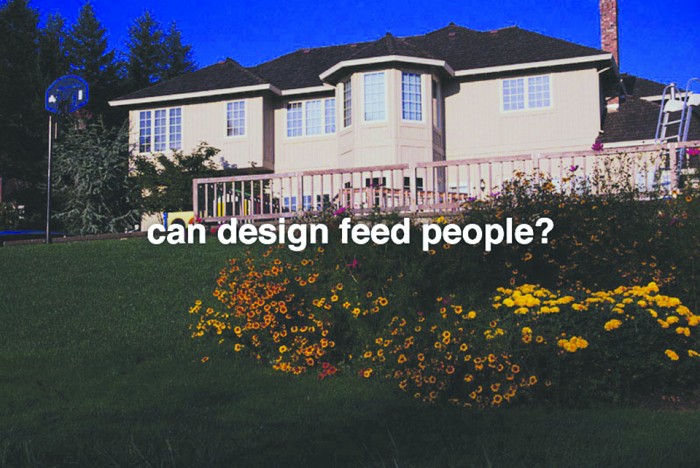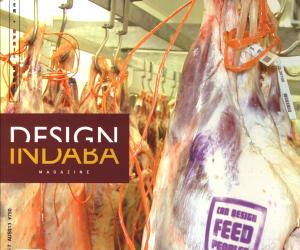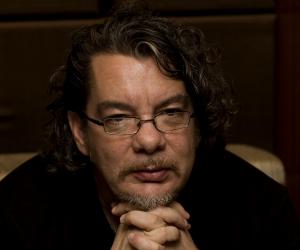First Published in

The title for this lecture was a panic decision made within the space of a couple of seconds when pressed over the phone for the title by Shaheda, who is organising this conference. I appreciate it really, Shaheda. It was an instant response, but, I must admit, at that time I had little idea why or what it could mean. I had never really thought about this before, certainly not in such depth. All I had been feeling was a growing unease over many years about what I was doing.
The question hung over me, and slowly became a heavier and heavier loop, spiralling in on my daily activities. I started to look around for some possible clues in order to resolve an answer, to create a context in which I could begin to look at the role of design, and my role within it.
I immersed myself totally in an online information jungle, and quickly drowned in an ocean of hard facts. Each fact led to another ten connections, and each in turn to another ten in a never-ending spiral of links. These facts were shocking to me, and as each one was uncovered, the consequences of the statistics began to reveal my planet to be a planet I did not know. A culture shock.
And these facts, when laid out on the dining table, started to reveal links and parallels with each other, forming a matrix of echoes and reflections, a grid of interwoven cause and effect. Not the virtual web of computer cables, or the sprawling network of travel and tourism, but a flowing, fluid dynamic of extreme contrasts and seismic shifts, one set of facts overlaying another in a kind of disharmonic harmony.
The problem with human statistics is that they conceal the human. We hide behind a wall of figures and percentages, an info-wall, hoping against hope that the world of real individual pain will remain a virtual one, one in which death and suffering is somebody else's problem, where any remote suggestion of real emotion can be buried beneath the white pages of statistical papers.
You see, from where we stand, it seems pretty perfect. Excitement about new technologies and software justifies all our inactions. We obsess about communication. We foolishly imagine that this will somehow save the planet, yet all it does it keep us so busy that we don't have to think about anything (In fact, thinking is the key...).
Now some numbers. This is all about creating a perspective. This is serious stuff, and I was not sure whether this was the place to discuss it, but context is everything.



What we refer to as the digital divide is clearly more of a schism, a gaping, unbridgeable crack in the earth that acts more like a castle moat, protecting the haves from the have-nots and making them richer.
This is also placed firmly in perspective when we look at some world population statistics.



According to the Japanese government, if present population trends continue, by the end of the next millennium, Tokyo will be a ghost town, and Japan will be empty. The country's population will be just 500 by the year 3000, and just one by 3500. When that person dies, the Japanese nation will be no more - a mathematical certainty if Japanese women carry on having just 1.4 children each on average.

What this means is that in rich first world countries less people will share more money, while in developing third world nations limited resources will be spread thinner and thinner.

The rich get richer and the poor get poorer
You might think that we would be willing to share some of this success, but in fact official aid from rich to poor countries proportionately declined 25% between 1992 and 1997, and now stands at its lowest level in 40 years.
Globally, two billion people go hungry every day due to a combination of inequitable land distribution, soil erosion, lack of infrastructure, grinding poverty in cities, and people unable to buy food from the world market. Almost all the people born in the next 50 years are expected to end up in urban areas.
But there is no reason why anyone should go hungry or thirsty. The problem is poverty and inequality rather than technology, and distribution and politics more than production. The reality is that there is more than enough food to go round. Better management of agriculture, water supplies, land reform, fish farming, renewable energy and a move away from western diet of meat, should be well able to feed the ten billion people expected to be around in 2050. The problems, as today, will be in distribution and access to ever scarcer resources.

Why design?
The bigger question, or rather the question that this query, "can design feed people", engenders, is one about the role of design, and, in fact, the question is "why design?"
Like some cola, today's world of visual communication is largely a content free, artificially flavoured, infinitely reproducable soft drink based on a memory of addiction and sweetening our needs. No potential for sustenance or nourishment, and no enduring quality beyond an immediate quenching of thirst. A thirst for what? An endless yearning to fill the space, that gaping hole left when we are not fed or truly loved. As we cannot love ourselves, we crave substitute love from the outside, and we mould media into performing that virtual role for us.
In an attempt to fill the airwaves, we use padding. American TV today has over 12 000 hours of drama to fill every week. With what? Cliché seems to be the common currency, not a staple food, but a way of feeling fed. In fact, it is the business of media to make you feel fed, in the short term, and to return for more. And, like using monosodium glutamate, the food tastes great, is addictive, but can leave you feeling bloated and tired with a headache. But somewhere it leaves a trace of addiction, and, like addicts, we always return for more, our memories cleansed of the past but not free enough to assess the present or to imagine a different future. Branding means exactly that, a burning logo of ownership stamped forever on our psyche. It makes you feel a part of the herd, the global farm where difference means estrangement. No one wants to become a lost sheep, but we are all lambs to the slaughter. The brand is a membership card, it means joining the global club, enrolling in the race against mortality as if this modern race against time will stop death snapping at our designer heels.
Today, everything is branded. Reality is virtualised, and a logo is perceived as having more value than food or life-saving drugs. (More people know the name of Glaxo than the names of the drugs they supply.) The simplification of the world into easy-to-remember brands is at the price of diversity. It is at the price of local identity and pride.
Brands don’t feed people, they feed from them. Big brother is a cannibal. They appropriate indigenous cultures into their own, and regurgitate them as artificial authenticity. This impacts directly on people's sense of self-reliance, in their confidence of being able to survive on their own devices. We supplant people's cultures with a whitewashed simplicity that comes from elsewhere, and we use the tools of technology, fear and addiction to do this. We carve up the cow like a map and allocate each part to a leading brand. This is the so-called brand territory, and becomes a monopoly of all aspects of that cut of meat. Brand leaders are rarely vegetarian.

Patents are killing people
TRIPS is the acronym for the Trade Related Intellectual Property Agreement. As many of you know, it is the reason behind the current astronomical price of Aids-related drugs. The pharmaceutical cartel producing the drugs has used international patenting laws and the US government to force countries not to use generic copies and so potentially alleviate millions from suffering. Instead, trade sanctions are threatened against those countries who do not comply; specifically those with the greatest need, the highest rates of AIDS and the lowest income. Millions will die as a result.
Especially here in South Africa. Sometime soon, mortality from Aids will exceed the death toll of the worst outbreak of bubonic plague. Since the start of the Aids pandemic roughly 20 years ago, 20 million people have died and over 50 million have been infected. Seventy five percent of the world’s infected people are in Africa. South Africa has an estimated 20% of the population infected, and Botswana has over 36%. Again, the human is concealed by the numbers. In South Africa, researchers forecast that the GDP will be 17% lower by 2010 as a result. The human figures.
The rich get even richer and the poor pay the fees

This system ensures that the technology gap will never be closed, and developing countries, already saddled with huge debt repayments often higher than the national GDP, have to endure a crippling workforce collapse.
Again the information wall. A barrier that holds back the dam of mankind, rendering them virtual, and ensures the profit of those within.



Real money no longer comes from commodities. Cotton, coffee, cocoa, have all plumetted in value while since 1980 the value of hi-tech goods has doubled. For the clothing industry, the shift of production to the sweat shops of Asia is a minute cost compared to the investiture in image - brand development, design and advertising.

We are overweight, a 1st world nation of bloated media junkies stuffed on the fast food of digital shopping. Our mp3 plates are overflowing, and we just don't know what to do with all that stuff. It distracts us from thinking, which is the only point of it all.

Reproduction
As we head full speed towards physical human cloning, we are fast becoming a world of identical twins. The DNA of branding giants threatens to swallow up all other living DNA in its wake.
In our ivory tower, the future is seen as one in which scientific and technological evolution combined with branding will create a blemish-free, pain-free, shiny sanitised virtual world, one in which the (ugliness of the) real individual human will be excluded for fear of upsetting the codes. As we attempt to reduce all life to a set of patented codes, the biggest risk is that of natural evolution. Difference becomes the enemy of the state (of man.)
Baudrillard, the french writer in his book The Vital Illusion, when discussing the virtual immortality of cloning, says that: "It is culture that clones us, and mental cloning anticipates any biological cloning. It is the matrix of acquired traits that, today, clones us culturally under the sign of monothought – and it is all the innate differences that are anulled, inexorably, by ideas, by ways of life, by the cultural context. Through school systems, media, culture, and mass information, singular beings become identical copies of one another. It is this kind of cloning - social cloning, the industrial reproduction of things and people - that makes possible the biological conception of the genome and of genetic cloning, which only further sanctions the cloning of human conduct and human cognition."
Media isn't creative, it is reproductive, choosing to publish cloned clichés from a homogenised toolbox of ideas. It must be reproductive, dividing like viral cells, in order to be so pervasive and reach into the smallest part of the farthest culture. Like a hologram, one smallest fragment contains an image of the whole, and individual meaning, or any meaning for that matter, is excluded. Mediocrity with the sensory controls set full on.
Society would rather not be original, but to copy. Modern buildings with historic styles, every city a tourist version of itself. A holiday inn of reproduced paintings adorning the walls of identical rooms.
This is not real sex, or pro-creation. No, it is reproduction without sex, the pornography of promise. Immortality through cloning. Media has become sterile, one-directional, a self-reproducing monothought. The fantasy of excitement and promise, a place where Disney and sperm are frozen in cryogenics for future revival. What a thought.






Soulfood
But design can feed. There are many examples of visual communication that dares to risk difference. Many websites reveal experimental approaches to communication, (admittedly fairly content-free still).
Our souls need feeding. In the absence of faith, of religious foundations, the fast edited images. The hollow emptiness of cyberspace, the digital mirage leaves us yearning for sustenance at an existential level. Our existence is becoming sub-humanised, not superhumanised, and we ache for something real. Music, painting, stories, writing, film. All these are being sanitised by digital conversion and edited to meet market needs. The media itself has the power to free itself from its own fears. The liquid form of data is frozen, and we yearn for it to melt and flow, carrying differences and voices and emotions to feed us.
We need to open our trade to other skills, and allow the artists, filmmakers and musicians real access.

Feeding the frenzy
Design feeds our fears. It reinforces our deepest insecurities, that our survival depends on material wealth and power, and evolves them into highly sophisticated software systems, final solutions all based around and supporting the weapon of intellectual property. Designers are in the front line of an army of mental occupation.
There should be more than enough Love to go round, which should enable all other resources to be shared, but unfortunately we mostly live our lives based on fear. Our deep insecurities lead to us amassing huge sums of money and to focus so much energy on protecting it and excluding outsiders, who we fear will want somehow to steal it. We hypnotise and brainwash in order to spread our brands unchallenged.
We spy on each other. Our fear is so extreme, that corporations and governments use any opportunity to gather information about us (and each other). From the food we eat to our taste in music, from the time we arrive at work to the time we shop to what we buy, from the emails we send to the phone calls we make, from the TV we watch to the amount of children we have - somewhere exists bulging databases on our tastes, habits, passions and patterns. Our personalities and lives are reduced to codes that are subliminally exploited for someone else's commercial or political gain.

Dataveillane
This so-called "dataveillance" tracks us by monitoring the shadow we cast in data, and it's big business. BP recently admitted using secret microphones to listen to the private conversations of millions of customers at petrol stations. Many companies analyse customer data using highly sophisticated software to manipulate information. Many know when a customer is possibly about to "churn", that is, leave and take up the services of a rival company. They can then take evasive action unbenownst to the customer. Often, this highly sophisticated software has been developed for war or state espionage reasons and has been repurposed.
All mobile phone users can be tracked to within a 10 metre position using cellular tracking. Recently, phone users on a beach in Tel Aviv received SMS texts offering cheap boat trips. No one questioned how it was that they knew that they were there. Some tourist attractions are known to send messages to tourists nearby informing them of their presence. Cameras watch our every move outside the home. Credit card use tracks our journeys.
Cookies, software devices that jump to your PC when you log on to a web site, they send back information about where you surf, for how long and when, and will identify you when you return the next time. Eighty six percent of sites do this, and if you turn off the "accept cookies" preference, most sites will refuse you entry.

Everything happens in the kitchen
Yet here comes a dilemma. For a nation such as South Africa to survive, to feed all of its people, it must compete in a world market. This means it must embrace the rules of marketing, it must create a clear image and territory to own, it must become synonymous with specific easy-to-remember qualities. But maybe here is a chance to do some of the things a bit differently. South Africa is in a unique position in the world, in that it straddles both first and third worlds. This is invaluable. It means that, given enough courage, South Africa has the opportunity to input different cultural ideas, based on respect, and to alter the landscape in some way. It has the almost unrivalled potential to speak to and influence the cultures of both the first and third worlds.
If South Africa simply reproduces the existing mode of operation, it will be lost in the empirical sea of global culture. If it wants to stand out, it will need to support its young designers and artists in their attempts to find new forms, and to create a modern, multi-peopled culture to carry its messages. And in turn, you, the designers and creative professionals, will need to step outside and engage with the greater population at your doorstep. People count if we stop counting them.
My studio is faced with similar dilemmas. Do we completely abandon any corporate clients or branding work, or do we use it judiciously as income to finance more exploratory work which may make a difference to the way people see things? We constantly oscillate between these two extremes and try to work responsibly. There is no perfect solution, we just try to do the best we can and try to increase both our clients understanding and the experimentation of the work we produce.
(Anyone with a computer and access to the internet can market themselves and their ideas and products globally, and, as income and contacts expand, so can the increasing capital be reinvested to increase the potential market etc.)

There is no such thing as free meal
Design today feeds from the people it was once established to serve. It originated as a public service, but has descended into being a tool of economic manipulation. It is time to give something back. Design can feed people. As well as the obvious response that designers can help publicise the plight of those denied access to the same technological tools, an understanding of design can be used as a bridge to help better market and sell the raw commodities that would allow a people greater self-sufficiency. Design is an agitprop tool, best placed to use the international language to symbolise and identify a social struggle.
Education is the key. Design can be used to help empower a peoples to better express themselves in the world. It can be taught as a profession to underprivileged societies to help enable children to link with the rest of society and give them a better future in a world of communication.

Food for thought
Design can feed the mind by offering food for thought. It can challenge our ideas and break the rules and fixed genetic patterns that govern us. It is not in the interest of media and corporations for us to think. We can break that cycle and crack the code, and help encourage free thought. It can help generate a thing of genuine beauty, that of the soul liberated in free expression. Of depth of meaning and of a true link with the world around us.

All you need is love
There is enough love to go round, if only we have the courage to risk being different. No-one need go hungry, culturally, physically or spiritually. The distribution channels are there, albeit reaching as yet small populations. We, as providers and content creators have the keys to unlock true communication, communication with real meaning and the power to change our lives and the lives of others for the better through empowerment and respect.
We need to create a dialogue, not a monobrand, monothought monologue. One where the message itself may be altered, the grid rearranged.
If we are to not only survive as a species, but to prosper creatively and to evolve dynamically, we must recognise the whole human race as a brand, with all of its diversity and colour, its differences and sometimes its vetos. A brand based on respect, not power; possibility, not uniformity. Love, not fear.










